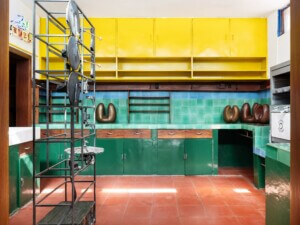Mexico City is the fifth largest city in the world, with over 17 million inhabitants. There, below the looming volcanic peaks of Popōcatepētl, a rising cadre of young designers is making its mark on this ancient megalopolis. Yes, the city’s architecture schools like Universidad Nacional Autónoma de México and Universidad Iberoamericana are bastions of the now-classical modernism of Luis Barragán and Ricardo Legorreta. But in a metropolitan area so vast and so densely packed—Mexico City reportedly has about four times the density of New York City—handcrafted and informal solutions are never out of reach. It’s within this tense, sweet spot that Mexico City designers truly excel: By combining high-design references with homespun folk art, designers are able to create works that are contemporary, but also contextual and artisanal, and that speak to the contested and refined realities of their home city. With a grab bag of contemporary stylistic influences coupled with the methodical pedagogy of their elders, the current generation of designers is quickly moving past the orthodoxy of the city’s Modernismo traditions toward new enterprises that blend design, architecture, and furniture. The city will host Design Week Mexico from October 5-9, 2016, will be the WorldDesign Capital in 2018—the sixth in the program and the first North American city to be named as such.
Escobedo Soliz
Established in 2011 by classmates Lazbent Pavel Escobedo Amaral and Andres Soliz Paz, who studied architecture together at the Universidad Nacional Autónoma
de México, Escobedo Soliz was awarded the prestigious 2016 Young Architects Prize (YAP) by the Museum of Modern Art for its Weaving the Courtyard project.
The firm’s ethos is rooted in mining the tectonics of history and tradition to inspire contemporary designs. With its YAP installation wrapped up, the firm is moving on to tackle several architectural projects it had in the pipeline prior to winning the prize.
Frida Escobedo
Among the best known Mexico City–based architects is Frida Escobedo, a graduate of Universidad Iberoamericana in Mexico City, and the Arts, Design, and the Public Domain program at the Harvard Graduate School of Design. She began her namesake firm in 2006 to much acclaim. The practice is known around the world for its critically engaging architecture: Escobedo’s weighty plaza installation for the 2013 LisbonArchitecture Triennale and her dynamic reinterpretation of the Mexican muralist David Alfaro Siqueiros’s home and studio stand out for their provocative embrace of rough materiality. In many ways, Escobedo, who cofounded her first firm, Perro Rojo, in 2003 at the age of 24, has been at the forefront of expressing the latent historical and stylistic tensions that define current architecture for years. The recent adoption and proliferation of her sensibilities among this younger group of designers prove she’s been right all along.
PACA
PACA is a dynamic group composed of a revolving door of collaborators that includes architects, designers, artists, biologists, and musicians. Founded by high school friends Carlos Maldonado and Juan Pablo Viedma in 2012, PACA’s industrial design sensibilities and collaborative organizational structure allow the firm to engage in a wide array of work in a variety of media, from pottery, furniture, and sculpture, to candy, short stories, and graphic design.
Lanza Atelier
Lanza Atelier, founded by Isabel Martínez Abascal and Alessandro Arienzo in 2014, embodies the multifaceted, holistic approach to design that defines many
of Mexico City’s young firms. Their work combines fine, modernist-inspired precision and methodology with everyday materials. Arienzo, who was taught by Escobedo while at Universidad Iberoamericana and later worked in her office before cofounding Lanza, said of the firm’s methodology: “We try to be more than an architecture studio. We don’t like to specialize in any one thing. Instead, we like to specialize in thinking and taking all scales into consideration.”
Pedro & Juana
Ana Paula Ruiz Galindo and Mecky Reuss, the designers behind Pedro & Juana, love to occupy contested territories, and describe themselves as “suspicious
of ‘big ideas.’” Graduates of SCI-Arc and Delft University, respectively, the duo loves to jump scales. The work, which ranges from public installations and one-off productions to buildings, straddles a wide line between architectural, interior, graphic, and furniture design.










